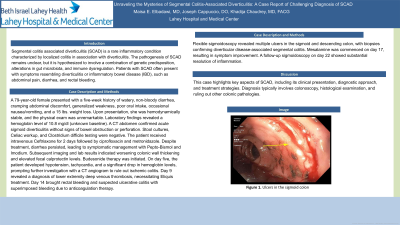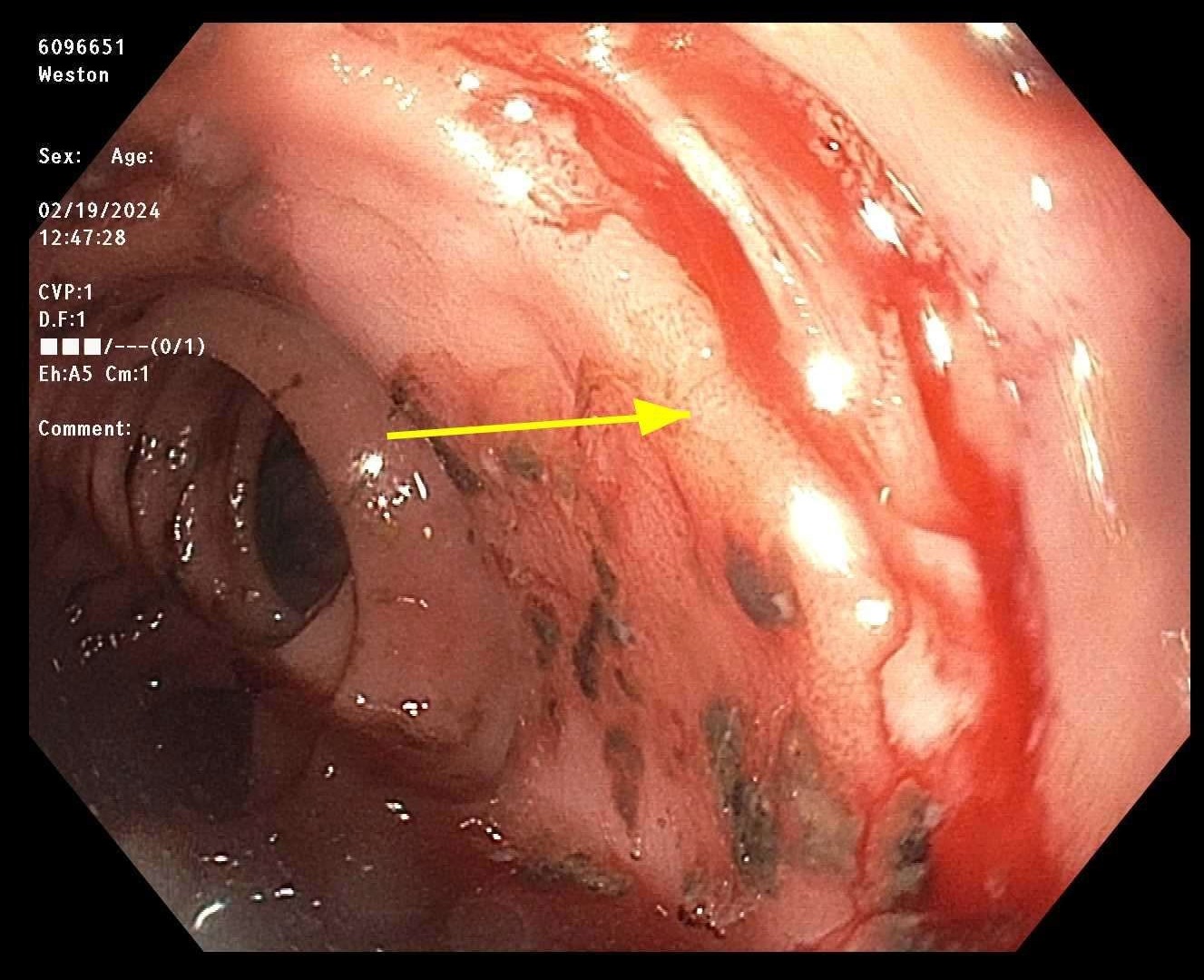Monday Poster Session
Category: Colon
P2005 - Unraveling the Mysteries of Segmental Colitis-Associated Diverticulitis: A Case Report of Challenging Diagnosis of SCAD
Monday, October 28, 2024
10:30 AM - 4:00 PM ET
Location: Exhibit Hall E

Has Audio

Maisa E. Elbadawi, MD
Lahey Hospital and Medical Center
Dracut, MA
Presenting Author(s)
Maisa E. Elbadawi, MD1, Joseph Cappuccio, DO2, Khadija Chaudrey, MD, FACG2
1Lahey Hospital and Medical Center, Dracut, MA; 2Lahey Hospital and Medical Center, Burlington, MA
Introduction: Segmental colitis associated diverticulitis (SCAD) is a rare inflammatory condition characterized by localized colitis in association with diverticulitis. The pathogenesis of SCAD remains unclear, but it is hypothesized to involve a combination of genetic predisposition, alterations in gut microbiota, and immune dysregulation. Patients with SCAD often present with symptoms resembling diverticulitis or inflammatory bowel disease (IBD), such as abdominal pain, diarrhea, and rectal bleeding.
Case Description/Methods: A 79-year-old female presented with a five-week history of watery, non-bloody diarrhea, cramping abdominal discomfort, generalized weakness, poor oral intake, occasional nausea/vomiting, and a 15 lbs. weight loss. Upon presentation, she was hemodynamically stable, and the physical exam was unremarkable. Laboratory findings revealed a hemoglobin level of 10.8 mg/dl (unknown baseline). A CT abdomen confirmed acute sigmoid diverticulitis without signs of bowel obstruction or perforation. Stool cultures, Celiac workup, and Clostridium difficile testing were negative. The patient received intravenous Ceftriaxone for 2 days followed by ciprofloxacin and metronidazole. Despite treatment, diarrhea persisted, leading to symptomatic management with Pepto-Bismol and Imodium. Subsequent imaging and lab results indicated worsening colonic wall thickening and elevated fecal calprotectin levels. Budesonide therapy was initiated. On day five, the patient developed hypotension, tachycardia, and a significant drop in hemoglobin levels, prompting further investigation with a CT angiogram to rule out ischemic colitis. Day 9 revealed a diagnosis of lower extremity deep venous thrombosis, necessitating Eliquis treatment. Day 14 brought rectal bleeding and suspected ulcerative colitis with superimposed bleeding due to anticoagulation therapy. Flexible sigmoidoscopy revealed multiple ulcers in the sigmoid and descending colon, with biopsies confirming diverticular disease-associated segmental colitis. Mesalamine was commenced on day 17, resulting in symptom improvement. A follow-up sigmoidoscopy on day 22 showed substantial resolution of inflammation.
Discussion: This case highlights key aspects of SCAD, including its clinical presentation, diagnostic approach, and treatment strategies. Diagnosis typically involves colonoscopy, histological examination, and ruling out other colonic pathologies.

Disclosures:
Maisa E. Elbadawi, MD1, Joseph Cappuccio, DO2, Khadija Chaudrey, MD, FACG2. P2005 - Unraveling the Mysteries of Segmental Colitis-Associated Diverticulitis: A Case Report of Challenging Diagnosis of SCAD, ACG 2024 Annual Scientific Meeting Abstracts. Philadelphia, PA: American College of Gastroenterology.
1Lahey Hospital and Medical Center, Dracut, MA; 2Lahey Hospital and Medical Center, Burlington, MA
Introduction: Segmental colitis associated diverticulitis (SCAD) is a rare inflammatory condition characterized by localized colitis in association with diverticulitis. The pathogenesis of SCAD remains unclear, but it is hypothesized to involve a combination of genetic predisposition, alterations in gut microbiota, and immune dysregulation. Patients with SCAD often present with symptoms resembling diverticulitis or inflammatory bowel disease (IBD), such as abdominal pain, diarrhea, and rectal bleeding.
Case Description/Methods: A 79-year-old female presented with a five-week history of watery, non-bloody diarrhea, cramping abdominal discomfort, generalized weakness, poor oral intake, occasional nausea/vomiting, and a 15 lbs. weight loss. Upon presentation, she was hemodynamically stable, and the physical exam was unremarkable. Laboratory findings revealed a hemoglobin level of 10.8 mg/dl (unknown baseline). A CT abdomen confirmed acute sigmoid diverticulitis without signs of bowel obstruction or perforation. Stool cultures, Celiac workup, and Clostridium difficile testing were negative. The patient received intravenous Ceftriaxone for 2 days followed by ciprofloxacin and metronidazole. Despite treatment, diarrhea persisted, leading to symptomatic management with Pepto-Bismol and Imodium. Subsequent imaging and lab results indicated worsening colonic wall thickening and elevated fecal calprotectin levels. Budesonide therapy was initiated. On day five, the patient developed hypotension, tachycardia, and a significant drop in hemoglobin levels, prompting further investigation with a CT angiogram to rule out ischemic colitis. Day 9 revealed a diagnosis of lower extremity deep venous thrombosis, necessitating Eliquis treatment. Day 14 brought rectal bleeding and suspected ulcerative colitis with superimposed bleeding due to anticoagulation therapy. Flexible sigmoidoscopy revealed multiple ulcers in the sigmoid and descending colon, with biopsies confirming diverticular disease-associated segmental colitis. Mesalamine was commenced on day 17, resulting in symptom improvement. A follow-up sigmoidoscopy on day 22 showed substantial resolution of inflammation.
Discussion: This case highlights key aspects of SCAD, including its clinical presentation, diagnostic approach, and treatment strategies. Diagnosis typically involves colonoscopy, histological examination, and ruling out other colonic pathologies.

Figure: Multiple Ulcers in the Sigmoid Colon
Disclosures:
Maisa Elbadawi indicated no relevant financial relationships.
Joseph Cappuccio indicated no relevant financial relationships.
Khadija Chaudrey indicated no relevant financial relationships.
Maisa E. Elbadawi, MD1, Joseph Cappuccio, DO2, Khadija Chaudrey, MD, FACG2. P2005 - Unraveling the Mysteries of Segmental Colitis-Associated Diverticulitis: A Case Report of Challenging Diagnosis of SCAD, ACG 2024 Annual Scientific Meeting Abstracts. Philadelphia, PA: American College of Gastroenterology.
